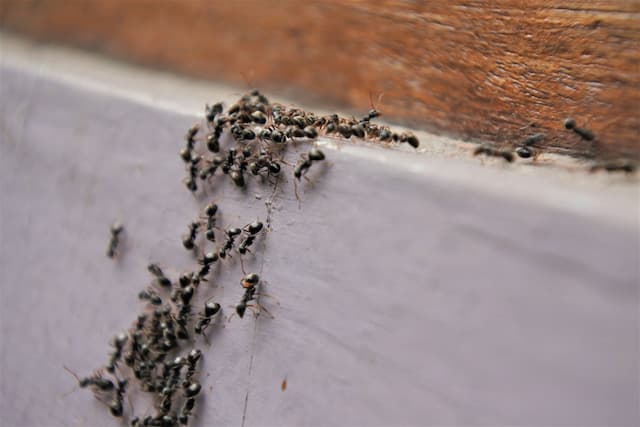Carpenter ants are black and vary in size anywhere between 0.14 inches to 1 inch in length. In North America, more than 93 percent of all homes have a wood frame. The damage carpenter ants can cause is significant and structural. Even though this type of ant is ubiquitous in America, they are one of the most difficult species of ants to control. For control of this pest, the first step is the identification of the pest you need to control. If they also have wings, they are in their mating season. Carpenter ants can be black, red, yellow or orange. They also have pinched mid-sections and bent antennae.
Each of these points is a good indicator of the presence of carpenter ants.
Carpenter ants nest in wood frames. Unlike termites, they do not eat wood. They leave small collections of wood dust from making channels in the wood, as they make their nests. The nests can be found in any wood in the home, such as wood flooring, wood framing, furniture or loose wood supplies.
Both hidden noise and scratching sounds are an indicator of carpenter ants’ presence. These sounds are made by scratching during the building of nests, communicating and mating activity.
Visual contact is a good way to detect the presence of carpenter ants. You may see swarms of winged ants leaving nests as they head out to find new nesting areas. You may also see them exploring while looking for particles of food scraps to take back to the nest. Regardless of the number of carpenter ants that you see, it is rare for more than 5% of the nest to be outside at any one time.
There are natural ways to get rid of carpenter ants. Natural methods are better for your home and family and can work just as well. If you have identified the presence of carpenter ants now try the following things to eliminate or restrict their presence.
Keeping a clean home is important. The cleaner the building the less is the possibility that carpenter ants will set up home. Make sure there is no excess lumber or timber inside or adjacent to your home. Always keep food in closed airtight containers. Planting marigolds both inside and outside the home is a good way to keep carpenter ants away. Make sure no wet, damp or very high humidity areas exist in your home. Carpenter ants are attracted to high humidity wood because this provides wood that is much easier for them to work into nests.
Using peppermint scents in ant traffic areas works very well. This is often a successful and natural way of getting them to abandon a net.
If the above methods fail, combine something they crave with something that kills them. Baited traps on small pieces of cardboard with a mixture of honey and boric acid, in limited amounts. Ensure that children and pets are not allowed to access these baits. Dealing with carpenter ants can be difficult. If all control methods fail, perhaps it’s time to call an ant exterminator.

